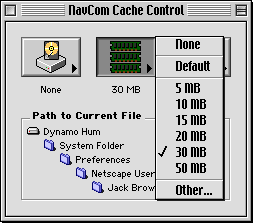Review: NavCom Cache Control 2.0

Product Information
Published by: Day Job Softwerks
E-Mail: dayjob@kagi.com
Shareware Fee: $3-$5
System Requirements
Power PC, Mac OS 8.0 or higher, Netscape Navigator 4.x
Ask any group of computer users—regardless of choice of platform—what their largest problem is with computing, and you are likely to get overwhelmed with complaints about the time it takes to get anything done online. The “World Wide Wait” is not just a slogan for those with slow computers or modems; even those blessed with the latest in modern technology are limited by their browser-of-choice’s ability to render today’s complex web pages quickly and accurately. For Mac users of Netscape’s Navigator or Communicator, a new tool has been created to help speed up your daily surfing: NavCom Cache Control by Jack Browning. You can try the time-expiring demo for 14 days without registering; afterwards you can register for a very nominal Shareware fee of $3.00 (cash or cheque sent to Jack Browning) or $5.00 (via Kagi). A registration program is provided with the download.
Both Netscape Navigator and the full-featured Communicator (I’ll just call them both Netscape for purposes of this review) use disk caching to enhance their performance. Information gathered from Web pages is stored locally on the hard drive in a folder called Netscape Cache in the Netscape Preferences Folder. When a page is reloaded or the “Back” button is activated, Netscape searches the Cache Folder for as much information as possible before seeking the rest from the internet connection. This effectively speeds up page reloading; and when visiting sites that do not change often, dramatically increases loading speed. The limiting factor in this process is the hard drive access speed, which varies from model to model. Faster processors, faster SCSI data throughput, and hard drive speed itself can dramatically alter the perceived response of the browser.
It would be much faster to use your Mac’s memory to store the cache files, since memory access is many times faster than disk access. The Netscape Preferences do not allow the user to adjust the memory cache without modifying Netscape’s resources with ResEdit—not for the timid. NavCom Cache Control is an application that modifies your Netscape Preferences to use Memory Cache instead of Disk Cache in an easy-to-use window.
The installation of NavCom Cache Control (NCCC, or N3C) is very easy. It is an application and thus can be stored anywhere, the only caveat being to keep all the installed N3C files in their original folder so the program can function properly. N3C does not install any extensions, and is only active when you set up (or modify) your Netscape Preferences. N3C comes with an excellent HTML-based user’s manual. It is one of the best, most easy to comprehend manuals of any shareware program that I have ever seen. Kudos aplenty to Jack for this.
Using N3C is also very straightforward. Launch N3C (with your browser
off), and you will see a dialogue box allowing you to select your individual user preferences if there is more than one user on your Mac. After selecting your preferences file you will see the main N3C window, where you can modify your settings.

The first button controls Disk Cache size. Since we want to use memory cache, set this to “None.” The second button controls the Memory Cache size. You can let N3C set the size based on your available memory by selecting “Default,” or you can select any size you wish, with the only limiting factor being your available memory. The last button controls how often your browser compares its files to the Internet. Since you are using memory cache, the cache files will not be saved after shutdown. Save your selections, close N3C, and you’re ready to go!
My experiences with N3C are difficult to objectively quantify. The vagaries of Internet connection rates from connection to connection make it nearly impossible to provide figures for perceived improvement. So I will only attempt to try to explain what I encountered in my use of N3C. I did not get any real sense that pages loaded a lot faster upon revisiting later in a session, but I did notice a general perking-up of Netscape‘s activity. Although I have chosen Netscape as my preferred browser, I have on occasion used various versions of Internet Explorer. One of the most noticeable differences to me between the two browsers has been IE’s ability to cache pages for more rapid (nearly instant in some cases) reloading. I think N3C now puts Netscape squarely on an even ground in this feature. Pages reloaded very quickly when I hit the “Back” button, a definite improvement over my old settings.
I think NavCom Cache Control is a very well-executed, viable option for Netscape users to evaluate. Your results may vary, but for the price it’s hard to beat. Since you can demo it for 14 days, I’d recommend that everyone who wants faster browser performance download and try NavCom Cache Control.
Reader Comments (2)
I was hoping you might know where writer of the software has gone to ground.
Thanks a lot, (and for the very helpful review).
Karen
Add A Comment